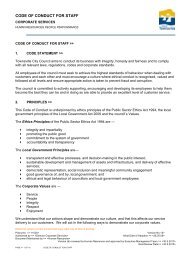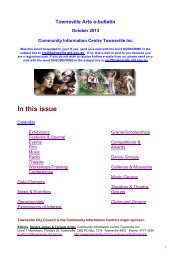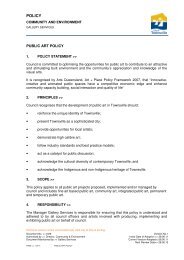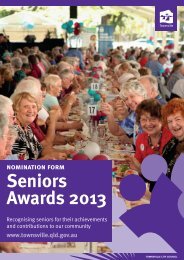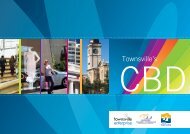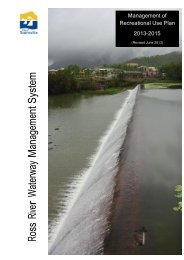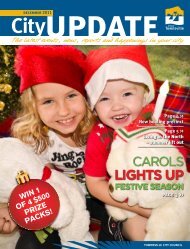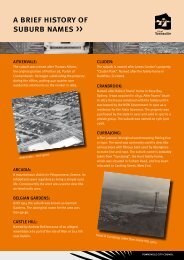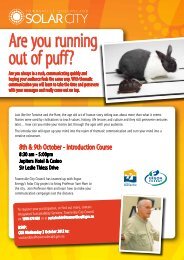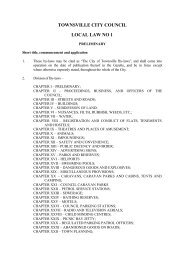education resource and teacher's notes - Townsville City Council
education resource and teacher's notes - Townsville City Council
education resource and teacher's notes - Townsville City Council
Create successful ePaper yourself
Turn your PDF publications into a flip-book with our unique Google optimized e-Paper software.
EDUCATION RESOURCE AND TEACHER’S NOTES<br />
Image: Patricia Piccinini Killing Time 2002<br />
Digital C-Type Photograph, 103.5 x 184 cm<br />
Courtesy of the Artist, Tolarno Galleries<br />
<strong>and</strong> Roslyn Oxley9 Gallery<br />
1.
Partnership between Gallery Services <strong>and</strong> the Sucrogen <strong>Townsville</strong> 400<br />
Activity dates:<br />
Until 16 June<br />
As part of VRROOOM, children have the opportunity to Design Your Own Car which could be doing laps at<br />
the Sucrogen <strong>Townsville</strong> 400!<br />
At the drawing station within the exhibition, children are encouraged to draw their most imaginative car.<br />
Completed designs are to be h<strong>and</strong>ed to the Perc Tucker Regional Gallery reception desk by<br />
2pm Sunday 16 June to be in the running to be one of 300 shortlisted designs printed as coloured decal<br />
stickers <strong>and</strong> exhibited at The Galleria (Riverway Arts Centre foyer) from 9 July until 4 August.<br />
A leading V8 Supercar driver will be judging the shortlisted decal designs <strong>and</strong> selecting one to display on his<br />
car during the Sucrogen <strong>Townsville</strong> 400!<br />
9.
Image: Patricia Piccinini Downpour 2002, Digital C-Type Photograph, 103.5cm H x 184cm W. Courtesy of the Artist, Tolarno Galleries <strong>and</strong> Roslyn Oxley9 Gallery<br />
Born in Sierra Leone, Africa in 1965, Melbourne-based artist Patricia Piccinini first arrived in Australia<br />
in 1972. In 1994-95 Piccinini developed the Mutant Genome Project, comprising a series of computergenerated<br />
photographs <strong>and</strong> new media installations exploring issues relating to genetic engineering <strong>and</strong><br />
‘consumer medicine’. This project was a turning point for Piccinini’s practice, setting it up to be delicately<br />
positioned between powerful aesthetics <strong>and</strong> compelling ethical concepts.<br />
Patricia Piccinini’s practice incorporates still <strong>and</strong> computer-generated images, interactive CD-ROMs,<br />
immersive videos, sculptural installations <strong>and</strong> film. Her work is recognisable around the world, <strong>and</strong> she<br />
has set herself apart from most of her contemporaries with her ability to pose questions <strong>and</strong> make<br />
observations about some of the most delicate <strong>and</strong> problematic ethical dilemmas of our time. This has been<br />
achieved with a great deal of sophistication by the use of highly resolved aesthetics <strong>and</strong> processes. Piccinini<br />
states “There are several questions that I always ask myself, <strong>and</strong> that are the base of my work: What is the<br />
definition of ‘natural’ <strong>and</strong> the definition of ‘artificial’, <strong>and</strong> how do those definitions change over time”<br />
Piccinini is represented in Vrrooom with The Stags, a sculptural work of personified motorised scooters<br />
which pose questions about technological advancements, <strong>and</strong> a series of three large scale photographs.<br />
Image: Patricia Piccinini The stags 2008, Fibreglass, automotive paint, leather, steel, plastic, tyres, Two pieces: 177 x 183 x 102cm <strong>and</strong> 147 x 90 x 101cm; 196 x 224 x 167cm (installed variable).<br />
Purchased 2009 with funds from Estate of Lawrence F. King in memory of the late Mr <strong>and</strong> Mrs S.W. King through the Queensl<strong>and</strong> Art Gallery Foundation <strong>and</strong> the<br />
Queensl<strong>and</strong> Government’s Gallery of Modern Art Acquisition Fund. Collection: Queensl<strong>and</strong> Art Gallery
In her article School Boy Doodles, published in The Guardian UK on Monday 26 October 2009, Germaine<br />
Greer wrote of Ben Quilty’s art practice,<br />
“Ben Quilty was born a year after the Holden LJ Torana was built. The car was his darling, his ticket to ride,<br />
his way out of wherever... The car, a white 1972 Holden LJ Torana, was in no way a triumph of design, but<br />
it had become an icon in its own right. The Holden, though by then almost entirely made in Japan, was<br />
Australia’s car; <strong>and</strong> the Torana was Holden’s raciest model, built for speed <strong>and</strong> boy racers. What was more,<br />
[Quilty’s] pictures were wonderful, painted in what seemed to be a few strokes with a brush loaded with<br />
neat paint straight from the tube – blazing whites, midnight purples, throbbing golds. The unmistakeable<br />
contours of the Torana leapt from the canvas. Some might have argued that it was just too easy to paint<br />
a model that never moved, that artist Ben Quilty was merely engaged in a grown-up form of schoolboy<br />
doodling. Others realised that that was exactly the point: the male human’s obsessive, unending love affair<br />
with his car.”<br />
Quilty is at the forefront of contemporary art in Australia; his thick, impasto paintings are arresting <strong>and</strong><br />
iconic. This ability l<strong>and</strong>ed him the 2011 Archibald Prize, for a portrait of Margaret Olley, which in turn led to<br />
an invitation by the Australian War Memorial to be an Official War Artist in Afganistan.<br />
The artist’s Torana has been an enduring inspiration for his paintings, <strong>and</strong> four such works are exhibited<br />
as part of Vrrooom. The paintings celebrate car culture <strong>and</strong> the affinity man can feel with ‘his machine’.<br />
However, Quilty is not reckless in his adoration <strong>and</strong> championing of car culture; his more recent Crash<br />
paintings provide a cautionary tale demonstrating the dangers of pushing one’s car too far..<br />
Image: Ben Quilty, Torana No. 8 2007, Oil on linen, 170 x 160cm. Courtesy of the Artist <strong>and</strong> Jan Murphy Gallery<br />
13.
Image: Ben Quilty, Torana Nelson Street [detail] 2004, Oil on canvas, 50.6 x 30.8 cm. Ipswich Art Gallery Collection, 2005<br />
14. 15.
Image: Ben Morieson, still from Burnout 2004 - Overhead, video, 11 minutes. Courtesy of the Artist<br />
Having organised a ‘street meets<br />
art’ festival in Melbourne in 2001 to<br />
produce the work, Ben Moriseon’s<br />
Burnout - featuring eight drivers<br />
performing burnouts, doughnuts,<br />
corkscrews <strong>and</strong> line-work across<br />
a 70m x 30m tarmac - was<br />
subsequently hailed as the ‘World’s<br />
Largest Abstract Drawing Using<br />
Tyremarks’ in the 2002 Guinness<br />
Book of World Records.<br />
In her Supercharged: the car in<br />
contemproary culture catalogue<br />
essay We Make the Cars, <strong>and</strong> the<br />
Cars Make Us, Vanessa McRae<br />
describes Morieson’s video work;<br />
“A car performs choreographed manoeuvres under instructions from the artist for an enthusiastic audience.<br />
It is filmed from above, from a camera suspended from a cherrypicker. From this godly vantage point<br />
we can appreciate burnouts <strong>and</strong> doughnuts as drawing <strong>and</strong> the ability of the driver to control what is<br />
essentially out of control. For Morieson, the car becomes like the long-haired brush of the Zen calligrapher.”<br />
Both a production designer <strong>and</strong> artistic director, Morieson has experience working on a host of iconic<br />
Australian films <strong>and</strong> television shows, including The Castle, Rabbit Proof Fence, Frontline, Summer Heights<br />
High <strong>and</strong> Underbelly. He studied a Bachelor of Arts in Fine Art <strong>and</strong> Sculpture at the Royal Melbourne<br />
Institute of Technology (RMIT) from 1986 to 1988, <strong>and</strong> has previously been employed as a part-time<br />
lecturer in Film <strong>and</strong> Television Production Design at RMIT Screen.<br />
Image: Michael Zavros Mint, Nutmeg, Tobasco, Wheat, Lavender, Rose water, Tangerine,<br />
Licquorice, Gentian 1999, Oil on board, 45 x 45cm each.<br />
Ipswich Art Gallery Collection.<br />
Donated through the Australian Government’s Cultural Gift Program by the artist, 2011<br />
Michael Zavros is one of Australia’s most<br />
significant younger realist painters. He is<br />
fascinated by beauty <strong>and</strong> his subjects include<br />
leaping <strong>and</strong> falling horses, men in suits, high<br />
fashion, classical mythology <strong>and</strong> French neoclassical<br />
architecture.<br />
Michael Zavros was born in 1974 <strong>and</strong><br />
graduated from Queensl<strong>and</strong> College of Art,<br />
Griffith University, in 1996.<br />
Zavros has held solo exhibitions at the<br />
Institute of Modern Art, Brisbane; University<br />
of Queensl<strong>and</strong> Art Museum, Brisbane;<br />
Wollongong <strong>City</strong> Gallery, NSW, <strong>and</strong> many<br />
others. His work is held in many public <strong>and</strong><br />
corporate collections such as the National<br />
Portrait Gallery, Canberra; Tasmanian<br />
Museum <strong>and</strong> Art Gallery, Hobart; Artbank;<br />
<strong>and</strong> Gold Coast <strong>City</strong> Art Gallery.<br />
Testament to his reputation as an artist<br />
of refined skill Zavros won the 2010 Doug<br />
Moran Prize, <strong>and</strong> the 2005 Robert Jacks<br />
Drawing Prize, among others. His paintings of<br />
hubcaps highlight the beauty <strong>and</strong> simplicity<br />
of form of common objects.<br />
As an artist, Morieson has exhibited in galleries throughout Australia <strong>and</strong> in Germany, Switzerl<strong>and</strong>, Engl<strong>and</strong><br />
<strong>and</strong> China. He has also completed an Australia <strong>Council</strong> residency in Barcelona, Spain, where he made<br />
videos using radio controlled cars.<br />
17.
Vrrooom includes two sculptures by nationally<br />
recognised Victorian sculptor Eamon O’Toole, a<br />
self-confessed “revhead, artist <strong>and</strong> dirt bike rider.”<br />
His passion for motorsports is only matched by<br />
his enjoyment of the arts, <strong>and</strong> the two meet as<br />
O’Toole pays homage to his favourite <strong>and</strong> iconic<br />
motorbikes, cars, <strong>and</strong> motorsport heroes through<br />
his sculptures.<br />
Image: Eamon O’Toole Sidchrome tool cabinet 2006, plastic, enamel <strong>and</strong><br />
aluminium leaf, 141 x 89 x 31 cm.<br />
Ipswich Art Gallery Collection. A<br />
cquired through the Ipswich Arts Foundation, 2006<br />
The works are full-scale replicas h<strong>and</strong>crafted<br />
from plastic, aluminium <strong>and</strong> paint. However, the<br />
artist wants them to look h<strong>and</strong>made - heightened<br />
images of the pursuits <strong>and</strong> skills of his country<br />
childhood. ‘’It’s important to have the artist’s<br />
touch in them,’’ O’Toole says.<br />
Discussing his early progress as a sports-mad art student, <strong>and</strong> the intent of his sculptures, O’Toole stated,<br />
‘’I always thought art should be about what you like. Other people in high school art classes did things like<br />
classical nudes but I just couldn’t go down that path.’’<br />
‘’[My high school teacher] thought cars <strong>and</strong> bikes were boys’ stuff, <strong>and</strong> that I could have been a bit artier.<br />
But how they’re made is what’s interesting for me.’’<br />
O’Toole’s status as a leading contemporary artist was recently recognised with a 25 year retrospective<br />
exhibition Revhead: The Motorsport Art of Eamon O’Toole at Ipswich Art Gallery, which included<br />
sculptures of Ayrton Senna’s McLaren Formula One car <strong>and</strong> a ute.<br />
Image: Eamon O’Toole Dick Johnson’s Racing Helmet 2012<br />
H<strong>and</strong> moulded plastic, enamel paint, aluminium lead <strong>and</strong> textas, 25.5 x 33cm<br />
Ipswich Art Gallery Collection.<br />
Commissioned by the Ipswich <strong>City</strong> <strong>Council</strong>, 2012<br />
19.
Image: Phil Gordon Les 2003, Stoneware <strong>and</strong> enamel, 19 x 23 x 45cm. Ipswich Art Gallery Collection, 2003<br />
Phil Gordon Stock Car 2003, Stoneware <strong>and</strong> enamel, 13 x 21 x 45cm. Ipswich Art Gallery Collection, 2003<br />
20. 21.
Phil Gordon’s ceramic cars are playful <strong>and</strong> engaging - both Les <strong>and</strong> Stock Car are brutish looking machines<br />
that look straight from an episode of Wallace <strong>and</strong> Gromit.<br />
Gordon’s influences are varied; he graduated from the University of Tasmania with a Bachelor of Fine Arts in<br />
1983 before becoming a member of <strong>and</strong> exhibiting with the Chameleon Artist co-operative in Hobart in 1984.<br />
Gordon moved to Queensl<strong>and</strong> in 1985, <strong>and</strong> from 1986 to 1990 he worked in Fashion <strong>and</strong> Screenprinting,<br />
designing <strong>and</strong> printing, <strong>and</strong> building props <strong>and</strong> silly cycles for the hugely popular Expo 88, which is widely<br />
recognised as Brisbane’s ‘coming of age’.<br />
Phil then spent 5 years as creative advisor <strong>and</strong> food stalls co-ordinator of Woodford Folk Festival, <strong>and</strong> has<br />
worked on construction, design <strong>and</strong> concept development for the Shoe Theatre for a number of years. His<br />
ongoing interest in <strong>and</strong> engagement with cars was explored in his 2002 Doggett Street Gallery exhibition<br />
Road Works.<br />
Margaret Dodd was born in Berri, South Australia, in 1941. She was part of the ‘funk’ ceramic movement that<br />
originated in Davis, California, during the 1960s. Her work centres on the car as a twentieth century Australian<br />
icon; a theme that she has developed through ceramic <strong>and</strong> sculpture into video, film <strong>and</strong> installation.<br />
Her work has been collected by the National Gallery of Australia, Canberra as well as the state galleries<br />
of Victoria, South Australia, Western Australia <strong>and</strong> New South Wales. She lives <strong>and</strong> works in Adelaide,<br />
South Australia.<br />
Discussing Garage Deity, Dodds stated, “It was made thinking about kiln gods, <strong>and</strong> the relation between pre-<br />
Columbian ceramics <strong>and</strong> those 1950’s car designs with Indian names like Pontiac.”<br />
On the topic of the ceramic works she has produced in Australia after returning from Davis, California, she<br />
stated, “My best ceramic pieces in Australia have been the iconic (now) Holden cars of the 40’s <strong>and</strong> fifties,<br />
especially the ones I made for a film, This Woman is Not a Car, which were a Holden Bride, one with hair curlers,<br />
<strong>and</strong> so on. I still do ceramic sculpture, as well as video <strong>and</strong> film projects.”<br />
23.
Image: Margaret Dodd Garage Deity 1992, Earthenware, 23.8 x 20.6 x 27.8cm<br />
Ipswich Art Gallery Collection. Acquired through the Ipswich Arts Foundation, 2009<br />
24. 25.
Born in Brisbane in 1964 <strong>and</strong> living in Grafton, New South Wales, Moore has been holding solo exhibitions<br />
since 1988. His work, which is primarily painting but also sculptural, is held in high regard, with numerous<br />
pieces in important collections such as those of the National Gallery of Victoria, Melbourne, the National<br />
Gallery of Australia, Canberra, <strong>and</strong> the Queensl<strong>and</strong> Art Gallery, Brisbane.<br />
Moore has completed numerous significant commissions throughout his career, but he is perhaps best<br />
known for contributing many of the works used by Mambo Graphics in their surfwear ranges <strong>and</strong> other<br />
graphics since 1989.<br />
In 2001 the artist’s work was seen in a series of giant flags flown in the forecourt of the Museum of<br />
Contemporary Art, Sydney in a project shared between Mambo <strong>and</strong> the Country Women’s Association of<br />
Victoria.<br />
Also in 2001, Moore constructed the work GTS; a massive, six metre long inflatable plastic representation of<br />
a Monaro. The work was completed during a residency at the RAAF Base Amberley <strong>and</strong> was commissioned<br />
by Global Arts Link (Ipswich Art Gallery) as part of the RAAF’s eighty year anniversary celebrations. The<br />
final work was included in the exhibition Octane: Celebrating 80 Years of the Royal Australian Air Force,<br />
Ipswich Art Gallery.<br />
Image: Robert Moore GTS 1999, Moulded inflatable plastic with etching ink detail, 300 x 250 x 600 cm.<br />
Ipswich Art Gallery Collection. Commissioned with the<br />
assistance of a State Government Project Grant from Arts<br />
Queensl<strong>and</strong>, 1998-1999. Acquired with funds<br />
donated by Ross Llewellyn Holden through the<br />
Ipswich Arts Foundation, 1999<br />
27.
Many will recall Finn’s mural from the popular 2011 Xstrata Children’s Exhibition Zookini (artist<br />
pictured painting the work below).<br />
DENHAM ST<br />
Finn has been involved in many facets of commercial art. The last 20 years has been spent running her<br />
own business, including producing promotional <strong>and</strong> production banners, displays <strong>and</strong> sets, murals, folk<br />
art, signs, children’s art <strong>and</strong> various private commissions.<br />
Finn’s practice has also included transforming the children’s ward at the <strong>Townsville</strong> General Hospital<br />
with floor to ceiling murals.<br />
FLINDERS<br />
ST<br />
Based in Prospect, Adelaide, Ann Newmarch is<br />
a nationally acclaimed, senior artist, with over<br />
20 solo exhibitions <strong>and</strong> 100 group shows. Her<br />
work is represented in many major national <strong>and</strong><br />
international collections.<br />
Ann worked as an art lecturer for 32 years at<br />
the South Australian School of Art. She is widely<br />
acknowledged for her contribution to art <strong>education</strong>,<br />
experimental printmaking <strong>and</strong> the Australian<br />
Community Art movement.<br />
She is the recipient of numerous awards <strong>and</strong> in<br />
1998 was awarded the Order of Australia for<br />
services to art. A longst<strong>and</strong>ing feminist <strong>and</strong> social<br />
activist, Newmarch has worked around themes<br />
drawn from her own personal experiences as<br />
well as social issues <strong>and</strong> work on community <strong>and</strong><br />
collaborative projects. Her work is wide ranging <strong>and</strong><br />
she doesn’t hold to a prescriptive ‘signature’ style.<br />
Image: Ann Newmarch 200 Years: Willy Willy 1988, Colour screenprint,<br />
58.1 x 47.2cm. Gift of the Australian Bicentennial Authority <strong>and</strong> the<br />
National Gallery of Australia 1988. <strong>City</strong> of <strong>Townsville</strong> Art Collection.<br />
The work 200 years: Willy Willy was acquired into the <strong>City</strong> of <strong>Townsville</strong> Art Collection as part of The<br />
Bicentennial Folio: prints by twenty-five Australian artists 1988. The work “talks about the inroads<br />
of white technology into the Australian l<strong>and</strong>scape, cutting across Aboriginal culture <strong>and</strong> legends. In<br />
my As the Serpent Struggles series, I use the symbols of the car, the snake, the tyre-tread scar, with<br />
suggestions of an Aboriginal approach to painting without co-opting of style. I use various systems of<br />
representation to talk about the juxtaposition of black <strong>and</strong> white cultures.”<br />
“The snake, feared by white culture, represents the Great Rainbow Serpent, creator of life <strong>and</strong><br />
l<strong>and</strong>forms in the Aboriginal Dreamtime stories. The car, the truck, has been the vehicle for removal of<br />
many Aboriginals from their ancestral l<strong>and</strong>s; depositing them hundreds of miles away...so it has also<br />
become the only way to return. The desert l<strong>and</strong>scape is hostile to us <strong>and</strong> we view it from the artificial<br />
boundaries of cars.”<br />
29.
any piece of artwork painted or applied directly on a wall, ceiling or other large permanent surface. A<br />
particularly distinguishing characteristic of mural painting is that the architectural elements of the given space<br />
are harmoniously incorporated into the picture.<br />
is a type of slow-drying paint that consists of particles of pigment suspended in a drying oil, commonly linseed<br />
oil. The viscosity of the paint may be modified by the addition of a solvent such as turpentine or white spirit,<br />
<strong>and</strong> varnish may be added to increase the glossiness of the dried oil paint film.<br />
very thin sheet of metal that is usually made by hammering or rolling a piece of metal. Foils are most easily<br />
made with malleable metals, such as aluminium, copper, tin, <strong>and</strong> gold.<br />
any of a wide range of synthetic or semi-synthetic organic solids that are moldable. Plastics are typically<br />
organic polymers of high molecular mass, but they often contain other substances.<br />
1. preservation or restoration from loss, damage, or neglect.<br />
2. the protection, preservation, management, or restoration of wildlife <strong>and</strong> of natural <strong>resource</strong>s such as<br />
forests, soil, <strong>and</strong> water.<br />
3. the maintenance of a physical quantity, such as energy or mass, during a physical or chemical change.<br />
clay of a porous body which is waterproofed by a covering glaze <strong>and</strong> is fired to around 1100oC. The low<br />
temperature vastly exp<strong>and</strong>s the range of glaze colours available. The clay can be any colour.<br />
low temperature glaze that is applied on top of an already fired higher temperature glaze for decoration, also<br />
called on-glaze decoration. Enamels are usually re-fired to temperatures in the range of about 700oC to 800oC.<br />
1. the circumstances or conditions that surround one; surroundings.<br />
2. the totality of circumstances surrounding an organism or group of organisms, especially:<br />
a. the combination of external physical conditions that affect <strong>and</strong> influence the growth, development,<br />
<strong>and</strong> survival of organisms.<br />
b. the complex of social <strong>and</strong> cultural conditions affecting the nature of an individual or community.<br />
or Rainbow Snake is a common deity, often a creator god, in the mythology <strong>and</strong> a common motif in the art<br />
of Aboriginal Australia. It is named for the obvious identification between the colours of a rainbow <strong>and</strong> the<br />
shape of a snake.<br />
is a method of creating an image on paper, fabric or some other object by pressing ink through a screen with<br />
areas blocked off by a stencil.<br />
is clay that when fired to maturity becomes a sturdy,<br />
chip resistant material.<br />
1. the application of science, especially to industrial<br />
or commercial objectives.<br />
2. the scientific method <strong>and</strong> material used to achieve<br />
a commercial or industrial objective.<br />
3. electronic or digital products <strong>and</strong> systems<br />
considered as a group.<br />
is a fibre reinforced polymer; made of a plastic matrix reinforced by fine fibres of glass.<br />
to go from one place to another, as on a trip; journey.<br />
an object that can be inflated with a gas, usually with air, but hydrogen, helium <strong>and</strong> nitrogen are also used.<br />
a self-propelled wheeled conveyance, such as a car or truck, that does not run on rails.<br />
is a colour print from a colour negative. The term<br />
“Type C” is generally used to distinguish from R<br />
or Reversal prints or direct positive prints from<br />
transparencies (colour positives). Type C prints can<br />
also be made digitally.<br />
is an electronic medium for the recording, copying<br />
<strong>and</strong> broadcasting of moving visual images.<br />
31.
A Free Activity Booklet targeted at primary students designed in response to this exhibition with reference to the Department of<br />
Education <strong>and</strong> Training, Queensl<strong>and</strong> Visual Art Syllabus, is available at the Gallery. The exhibition also incorporates conent targeted specifically at<br />
secondary students, such as the numerous interactive elements, <strong>and</strong> questions prompting analytical discussion related to individual artworks.<br />
Free guided tours are available upon request, <strong>and</strong> for further information about <strong>education</strong> <strong>and</strong> public programs provided by the<br />
Gallery contact: Nic Horton Ι (07) 4727 9011 Ι nicholas.horton@townsville.qld.gov.au<br />
We would appreciate your feedback in response to the Gallery’s <strong>education</strong> program. To assist, a feedback form is available from the Gallery or<br />
online at: www.townsville.qld.gov.au<br />
Through Gallery Services, <strong>Townsville</strong> <strong>City</strong> <strong>Council</strong> owns <strong>and</strong> operates two premier regional galleries, Perc Tucker Regional Gallery in the city’s CBD,<br />
<strong>and</strong> Pinnacles Gallery located within the Riverway Arts Centre in Thuringowa Central.<br />
Perc Tucker Regional Gallery is located in one of <strong>Townsville</strong>’s finest heritage buildings, on the corner of Denham <strong>and</strong> Flinders Streets, in the city centre.<br />
The Gallery has a ground floor <strong>and</strong> first floor level with seven exhibition spaces. On display are works by north Queensl<strong>and</strong> artists as well as<br />
national <strong>and</strong> international touring exhibitions. Guided group exhibition tours are available upon request <strong>and</strong> prior bookings are essential.<br />
For further information about programs, membership, venue hire, or to place a booking, please contact Perc Tucker Regional Gallery:<br />
+61 (7) 4727 9011<br />
ptrg@townsville.qld.gov.au<br />
www.townsville.qld.gov.au<br />
Monday - Friday 10am - 5pm<br />
Saturday - Sunday 10am - 2pm<br />
Closed Public Holidays, Free Admission<br />
32.



